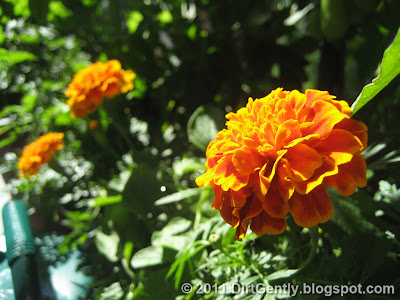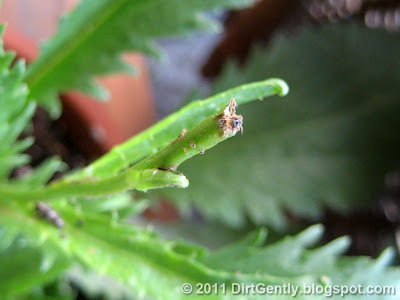One of the cedar planters has been rife with carrot-like seedlings all spring. I've been
generally very relaxed about weeding, but I've been quite relentlessly pulling these guys because of their numbers.
I'm happy that I did leave one around to grow up, because for one thing I get to identify the plant, and for another, they're quite nice and the smaller pollinators love them.
 |
| Oh how I wish for Smell-o-vision. The scent is indescribable, but I love it. |
It's
wild carrot (
Daucus carota). I guess the carrot-like appearance of the plant should have been a clue, but I like to be sure about these things. The plant is otherwise known as Queen Anne's Lace.
Apparently, they're good aphid repellents, which is fortunate since I do have a minor aphid problem.
One cool thing that I had never noticed before was that the umbrels nod and close up as the day ends, only to become erect and open up again as the sun rises. Pretty cool.
 |
| Feed me, Seymour! |
 |
| Was the international biohazard symbol inspired by this? |
According to some sites, young wild carrot (i.e., less than a year old) is just as edible as the cultivated kind that were derived from them, but I have also heard that it doesn't taste all that great.
As with the velvetleaf, I plan on investigating.
It should be notic that a couple of deadly poisonous species of hemlock can be confused with wild carrot (here's
a poison hemlock fact sheet), so if there are no more blog entries from me this fall, you'll know why :) Key differentiators: unlike hemlock, wild carrot roots smell like carrots and the stems are hairy; hemlock leaves smell musty while wild carrot leaves can smell like carrots; the central floret in the umbel of the wild carrot is often purple. The roots of the siblings of this plant that I've torn out definitely smell like carrots, the stems are very hairy, and the flower itself has a tiny purple floret, so I think I'm safe. Not sure about the carrot-scented leaf though; mine didn't smell of anything.
 |
| Hairy legs = good |
 |
| Spot the purple central floret 0_o |
 |
| A winner is you! |
Whether or not I eat it, I quite liked Queen Anne's Lace when I was young and I like them still, especially the architectural quality of the bracts, but the plants themselves can get quite big. I'll have to keep an eye on it to make sure it doesn't get out of control.
Speaking of out of control, remember
that lovely Epilobium I posted about last month? A week ago, it started setting seed on the main stalk, flowering from side shoots, and generally growing like a house on fire. I had to finally tear it out before it bullied the rest of the plants into submission. The way the seed pods opened was fascinating, though.
















































